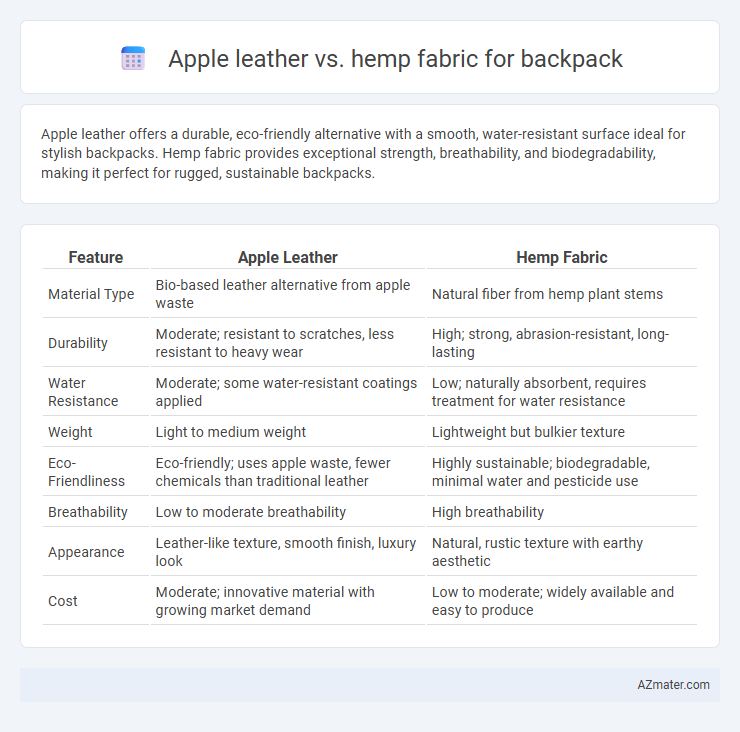Apple leather offers a durable, eco-friendly alternative with a smooth, water-resistant surface ideal for stylish backpacks. Hemp fabric provides exceptional strength, breathability, and biodegradability, making it perfect for rugged, sustainable backpacks.
Table of Comparison
| Feature | Apple Leather | Hemp Fabric |
|---|---|---|
| Material Type | Bio-based leather alternative from apple waste | Natural fiber from hemp plant stems |
| Durability | Moderate; resistant to scratches, less resistant to heavy wear | High; strong, abrasion-resistant, long-lasting |
| Water Resistance | Moderate; some water-resistant coatings applied | Low; naturally absorbent, requires treatment for water resistance |
| Weight | Light to medium weight | Lightweight but bulkier texture |
| Eco-Friendliness | Eco-friendly; uses apple waste, fewer chemicals than traditional leather | Highly sustainable; biodegradable, minimal water and pesticide use |
| Breathability | Low to moderate breathability | High breathability |
| Appearance | Leather-like texture, smooth finish, luxury look | Natural, rustic texture with earthy aesthetic |
| Cost | Moderate; innovative material with growing market demand | Low to moderate; widely available and easy to produce |
Introduction: Apple Leather vs Hemp Fabric for Backpacks
Apple leather, made from sustainable apple peels and cores, offers a durable, eco-friendly alternative to traditional materials with a smooth, leather-like texture ideal for stylish backpacks. Hemp fabric, derived from the sturdy fibers of the hemp plant, provides exceptional strength, breathability, and natural resistance to wear, making it a practical choice for rugged, long-lasting backpacks. Comparing these materials reveals key differences in environmental impact, durability, and aesthetic appeal for consumers seeking sustainable backpack options.
Material Origins: How Apple Leather and Hemp Fabric Are Made
Apple leather is crafted from the byproducts of apple juice and cider production, where leftover apple peels and cores are processed and combined with natural binders to create a sustainable, vegan alternative to traditional leather. Hemp fabric is derived from the stalks of the hemp plant, which are harvested, retted, and mechanically processed to extract fibers that are then spun into durable, breathable textile materials. Both materials emphasize eco-friendly production methods that reduce reliance on animal products and synthetic fibers while utilizing renewable agricultural resources.
Sustainability Comparison: Environmental Impact
Apple leather, produced from apple waste, offers a biodegradable and low-impact alternative to traditional leather, reducing agricultural runoff and deforestation associated with animal farming. Hemp fabric excels in sustainability due to its fast growth, minimal pesticide use, and ability to improve soil health, sequestering carbon dioxide efficiently. Compared to apple leather, hemp fabric generally requires less water and energy in production, making it one of the most eco-friendly materials for backpacks.
Durability and Longevity: Which Material Lasts Longer?
Apple leather offers moderate durability with water resistance and scratch resistance, making it a sustainable alternative to traditional leather but prone to wear over time. Hemp fabric excels in longevity due to its natural strength, resistance to abrasion, and ability to withstand harsh conditions, often lasting several years with minimal degradation. For backpacks requiring long-term durability, hemp fabric generally surpasses apple leather in lifespan and resilience.
Weight and Comfort: Carrying Experience Analyzed
Apple leather backpacks offer a lightweight alternative to traditional leather, enhancing comfort through its smooth, flexible texture that molds to the body over time. Hemp fabric backpacks are naturally breathable and durable, providing a slightly heavier but highly comfortable carrying experience due to its sturdiness and resistance to stretching. Comparing both materials, apple leather excels in lightness and softness, while hemp fabric ensures superior support and ventilation for extended wear.
Water Resistance and Weatherproof Qualities
Apple leather offers moderate water resistance due to its synthetic coating, making it suitable for light rain and damp conditions, while hemp fabric excels in breathability and durability but is naturally less water-resistant unless treated with waterproofing agents. Treated hemp fabric can provide enhanced weatherproof qualities, including resistance to mildew and mold, but often requires regular maintenance to sustain these properties. Apple leather's synthetic nature provides better consistent protection against moisture, making it more reliable for everyday exposure to wet weather in backpacks.
Style and Aesthetic Appeal
Apple leather offers a sleek, smooth finish with a contemporary and polished look that complements modern fashion trends, making it ideal for stylish urban backpacks. Hemp fabric provides a natural, textured appearance with an earthy, rustic charm that appeals to eco-conscious consumers valuing organic and artisanal aesthetics. Both materials enhance backpack design, with apple leather emphasizing sophistication and hemp fabric highlighting sustainable, bohemian style.
Maintenance and Cleaning Tips
Apple leather backpacks require gentle cleaning with a damp cloth and mild soap to prevent damage, avoiding harsh chemicals to maintain their eco-friendly surface. Hemp fabric backpacks offer durability and resistance to dirt, allowing for more robust cleaning methods such as machine washing on a gentle cycle or spot cleaning with mild detergent. Both materials benefit from air drying away from direct sunlight to preserve their texture and longevity.
Cost Analysis: Which Material Is More Affordable?
Apple leather typically costs more than hemp fabric due to its sustainable production process and limited supply, making it a premium choice for backpacks. Hemp fabric offers affordability with its fast-growing, renewable crop status and lower manufacturing expenses, appealing to budget-conscious consumers. Comparing prices, hemp backpacks generally provide a more cost-effective option without sacrificing durability and eco-friendliness.
Final Verdict: Best Choice for Eco-Friendly Backpacks
Apple leather offers a sustainable and biodegradable alternative to traditional animal leather, providing durability and a smooth texture ideal for eco-friendly backpacks. Hemp fabric stands out with its exceptional strength, natural antimicrobial properties, and faster growth cycle, making it an environmentally sound choice for long-lasting backpacks. For eco-conscious consumers seeking the best balance of sustainability, durability, and style, hemp fabric backpacks typically represent the superior option in eco-friendly materials.

Infographic: Apple leather vs Hemp fabric for Backpack
 azmater.com
azmater.com